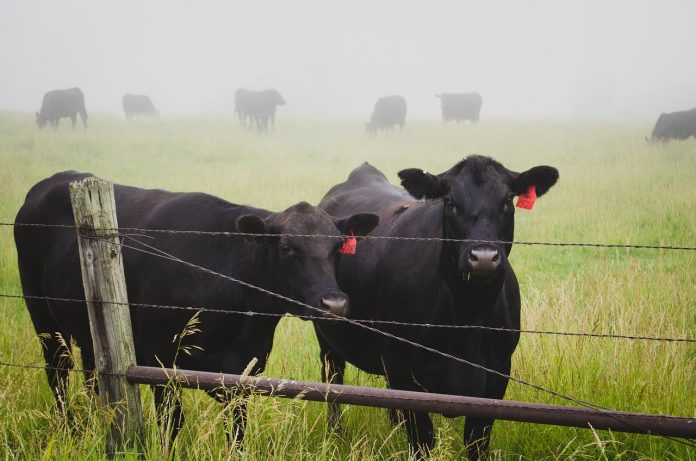Last week, we detailed the importance of an overall farm fencing plan. Now, it’s time to decide on the type of permanent and mobile fence you will use. The kinds of fences commonly used on farms include board, barbed wire, woven wire, cable, mesh, high-tensile, electric or a combination of any of these.

Livestock
The first consideration in deciding on what fence to use is its purpose. Fencing is most commonly used for livestock confinement, but species, age, breed and production system must be taken into account.
Cattle. Most fence types can be used for cattle, so assess factors such as expense, ease of construction and life expectancy of the material. Woven wire, barbed wire and high-tensile fences are commonly used. When bulls are penned separately, consider using heavy posts, with thick-gauge wire or cable and other strong electric fencing options. Fences for handling facilities should be strong, tall and visible.
Sheep. For sheep, predator control is a high priority. Electric fences are useful for discouraging predators such as wild dogs and coyotes. Barbed wire is not as effective for sheep, as the barbs tend to get covered in wool.
Horses. Visibility is necessary when selecting fencing for horses. Barbed wire can tear a horse’s hide, and horses can become entangled in high-tensile fences. High-tensile fences can be made more visible by placing posts closer together or hanging ribbons. Board fences are ideal for horses and woven wire fences can also be used.
Swine. Swine require strong fences built low to the ground to prevent them from escaping by rooting. Barbed wire along the bottom of the fence helps prevent rooting. Fences around swine confinement areas need to be strong and able to withstand heavy use.
Types of fences
1Rail fences
Rail fences are typically used as border fences around the farm and are popular on horse farms. These fences are available in PVC plastic, vinyl coated wooden boards, treated wood and painted wood. A high-tensile polymer fence has the look of a rail fence with high-tensile wires encased inside.
2Barbed wire fence
Barbed wire fences are made of two or more strands of smooth, galvanized-coated, steel wire twisted together with two or four barbs spaced every four to five inches and generally classified as either a standard or suspension barbed wire fence.
Standard barbed wire fences usually have three to five strands of wire between posts spaced between 15 and 25 feet apart, while suspension fences use four to six strands of wire taut between posts.
3Woven wire fence
Woven wire fences consist of a number of horizontal lines of smooth wire held apart by vertical wires called stays. The height of most woven wire ranges from 26 to 48 inches and depends on the jumping ability of the livestock species.
4Mesh wire fence
Mesh wire fences are strong and provide livestock safety. They are replacing board fencing in many areas, but are more expensive than woven wire. Because of the cost, they are used primarily for confinement fencing around corrals, feed lots, or small crop acreage areas. They also work well for horses.
5High-tensile fences
High-tensile fences are some of the most popular types of fences used. The advantages of high-tensile fencing: easier to construct, lasts longer, costs less to build, requires less maintenance.
Wires are held in tension along wood, fiberglass, insulated metal posts or a combination of posts and battens or droppers. These fences should be used with electricity to improve animal holding capability and predator control.
6Cable fences
Because of their expense, cable fences are used primarily for confinement areas, such as holding pens, feed lots and corrals. Cable fences consist of 3/8-inch smooth, steel wire cables stretched from one anchor post to the next. Each cable is made out of seven strands of wire twisted together.
There is no limit to the number of cables used, but, a six-cable fence is typically used for large animals. Spacing between cables depends on the species of livestock being confined.
7Electric fences
Electric fences are widely used in many livestock operations because they can be a safe, effective and inexpensive means of permanent or temporary fencing if constructed properly and energized with a properly sized controller for the area being confined.
Polywire strands, or ribbons, are the most commonly used. Aluminum, stainless steel and high-tensile wire can also be used — these wires can conduct electricity better for longer distances but are less visible to livestock.
A strand of electric fencing added to other types of fencing usually improves effectiveness.
Sources: University of Georgia Cooperative Extension and University of Tennessee Institute of Agriculture.
Next week: Farm and Dairy will provide additional tips on safely installing fences.
(Farm and Dairy is featuring a series of “101” columns throughout the year to help young and beginning farmers master farm living. From finances to management to machinery repair and animal care, farmers do it all.)
More Farming 101 columns:
- How to create a fencing plan
- 7 steps for easy sprayer calibration
- Prepare for planting season, Part 2: Calibration
- Prepare for planting season, Part 1: The Basics
- 7 tips to improve security on your farm
- 5 tips to protect your farmland
- 3 measures to deal with severe farm debt
- How to buy time to catch up on farm debt
- 6 tips to manage income on the farm
- 5 tips to recognize and deal with farm stress
- How to prepare a livestock birthing kit
- 5 tips for marketing your farm
- How to develop farm mission, vision statements
- 5 tips for setting farm goals
- 2 types of livestock insurance policies
- 6 things you need to know about WFRP plans
- 3 basics of crop insurance
- How does liability insurance work on the farm?
- Why do I need farm insurance?
- How to understand and use Ohio’s CAUV
- How to utilize the Pa. Clean and Green Act
- 9 tips for filing farm taxes
- 8 reasons record keeping for taxes is essential
- 5 tips for post-harvest storage
- 7 tips for family meetings on the farm
- 4 tips for balancing your farm and family
- 4 tips for communicating on the family farm
- 4 tips for firing an employee
- 6 tips for keeping good farm help
- 4 tips for recruiting farm labor
- 5 general farm labor laws
- 4 tips for employing minors
- 4 tips for PTO safety
- 5 things young farmers should know about finances
- The farm balance sheet
- 5 items for your farm’s cash flow statement
- Personal and business records: Keep them separate
- What to include in your farm business plan
- How to approach a lender: Tips for getting a farm loan
- How to use microloans to get your farm started
- Saving for the future: 6 tips for young farmers
- How to create a farm safety kit
- 5 tips for child safety on the farm
- 4 tips for transporting livestock
- 5 ways to better understand tractor stability
- 6 farm equipment hacks












We are looking to get into some ranching to diversify the farm and we know that we would need cattle fencing. It is good to know that cows can use most types of fences. I’ll probably use cattle fencing around the feedlots like you suggest.
Ah, it’s good to know that mesh wire fences are good for containment areas around corrals. I’m actually hoping to get some fencing put up around our land. It’d be nice to know that wherever our dog wanders off to, she can’t wander too far.
I completely agree with the thoughts of the writer as described in this article. Choosing the right fence for your farm is very much essential and necessary. We all must follow this article.